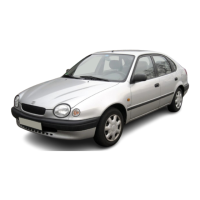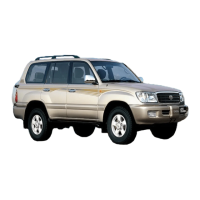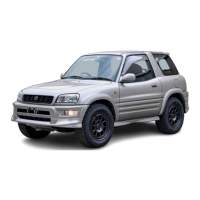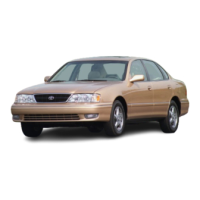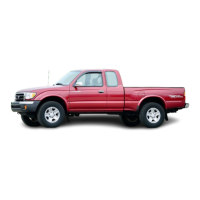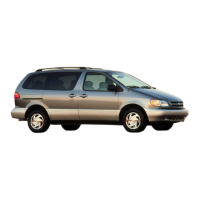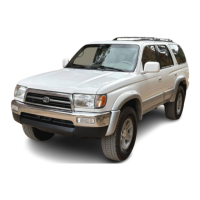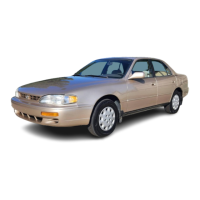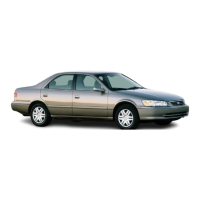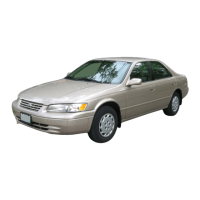Do you have a question about the Toyota 1998 Camry and is the answer not in the manual?
Provides an overview of the vehicle's instruments and controls.
Details the components and layout of the instrument panel.
Explains the various gauges and indicators in the instrument cluster.
Describes the meaning of various warning lights and symbols on the dashboard.
Covers the operation and features related to vehicle keys and doors.
Details the master and subkeys and their functions.
Explains keys featuring transponder chips for the immobiliser system.
Explains the operation of the wireless remote control system.
Covers seats, seat belts, steering wheel, and mirrors.
Guidelines for proper seating and occupant safety.
Information and precautions regarding seat belt usage.
Information on how SRS airbags protect occupants.
Operation of lights, wipers, and defogger systems.
Operation of headlights, high/low beams, and turn signals.
Operation of windshield wipers, washers, and interval adjustments.
Covers gauges, meters, and service reminder indicators.
Explains the fuel gauge operation and low fuel warning light.
Explains the meaning of various service reminder lights and buzzers.
Covers ignition switch, transmission, and parking brake operation.
Details on operating the automatic transmission and its selector lever.
Operation and setting of the cruise control system.
Covers car audio system and air conditioning system.
Details the controls for the air conditioning system.
Information on other vehicle equipment like clock and cup holders.
Explanation of the traction control system and its operation.
Guidelines for the initial driving period to ensure vehicle longevity.
Information on the correct type of fuel and fuel tank capacity.
How the ABS system works and what the warning light signifies.
Information on different types of tires and their suitability.
Checks to perform before turning the ignition key to start.
Specific advice for driving safely in winter conditions.
Guidelines and precautions for towing a trailer.
Troubleshooting steps if the vehicle fails to start.
Instructions for safely changing a flat tire.
Methods and precautions for towing the vehicle.
Common causes of corrosion and how to prevent it.
Guidelines for washing and waxing the vehicle for appearance and protection.
Items for regular checks and maintenance that can be done by the owner.
Clues and signs that indicate the vehicle may need professional repair.
Diagrams showing the location of key components in the engine compartment.
Important safety precautions to observe when performing DIY maintenance.
Procedure for checking and adding engine oil.
Importance and procedure for checking tire pressure.
Precautions and procedures for checking the battery's condition.
How to check for blown fuses and replace them.
Technical specifications for the vehicle's engines.
Specifications for tire sizes and pressures.
List and locations of vehicle fuses.
How U.S. owners can report safety defects to NHTSA.
Explanation of the uniform tire quality grading system.
Provides an overview of the vehicle's instruments and controls.
Details the components and layout of the instrument panel.
Explains the various gauges and indicators in the instrument cluster.
Describes the meaning of various warning lights and symbols on the dashboard.
Covers the operation and features related to vehicle keys and doors.
Details the master and subkeys and their functions.
Explains keys featuring transponder chips for the immobiliser system.
Explains the operation of the wireless remote control system.
Covers seats, seat belts, steering wheel, and mirrors.
Guidelines for proper seating and occupant safety.
Information and precautions regarding seat belt usage.
Information on how SRS airbags protect occupants.
Operation of lights, wipers, and defogger systems.
Operation of headlights, high/low beams, and turn signals.
Operation of windshield wipers, washers, and interval adjustments.
Covers gauges, meters, and service reminder indicators.
Explains the fuel gauge operation and low fuel warning light.
Explains the meaning of various service reminder lights and buzzers.
Covers ignition switch, transmission, and parking brake operation.
Details on operating the automatic transmission and its selector lever.
Operation and setting of the cruise control system.
Covers car audio system and air conditioning system.
Details the controls for the air conditioning system.
Information on other vehicle equipment like clock and cup holders.
Explanation of the traction control system and its operation.
Guidelines for the initial driving period to ensure vehicle longevity.
Information on the correct type of fuel and fuel tank capacity.
How the ABS system works and what the warning light signifies.
Information on different types of tires and their suitability.
Checks to perform before turning the ignition key to start.
Specific advice for driving safely in winter conditions.
Guidelines and precautions for towing a trailer.
Troubleshooting steps if the vehicle fails to start.
Instructions for safely changing a flat tire.
Methods and precautions for towing the vehicle.
Common causes of corrosion and how to prevent it.
Guidelines for washing and waxing the vehicle for appearance and protection.
Items for regular checks and maintenance that can be done by the owner.
Clues and signs that indicate the vehicle may need professional repair.
Diagrams showing the location of key components in the engine compartment.
Important safety precautions to observe when performing DIY maintenance.
Procedure for checking and adding engine oil.
Importance and procedure for checking tire pressure.
Precautions and procedures for checking the battery's condition.
How to check for blown fuses and replace them.
Technical specifications for the vehicle's engines.
Specifications for tire sizes and pressures.
List and locations of vehicle fuses.
How U.S. owners can report safety defects to NHTSA.
Explanation of the uniform tire quality grading system.
| Brand | Toyota |
|---|---|
| Model | 1998 Camry |
| Category | Automobile |
| Language | English |


